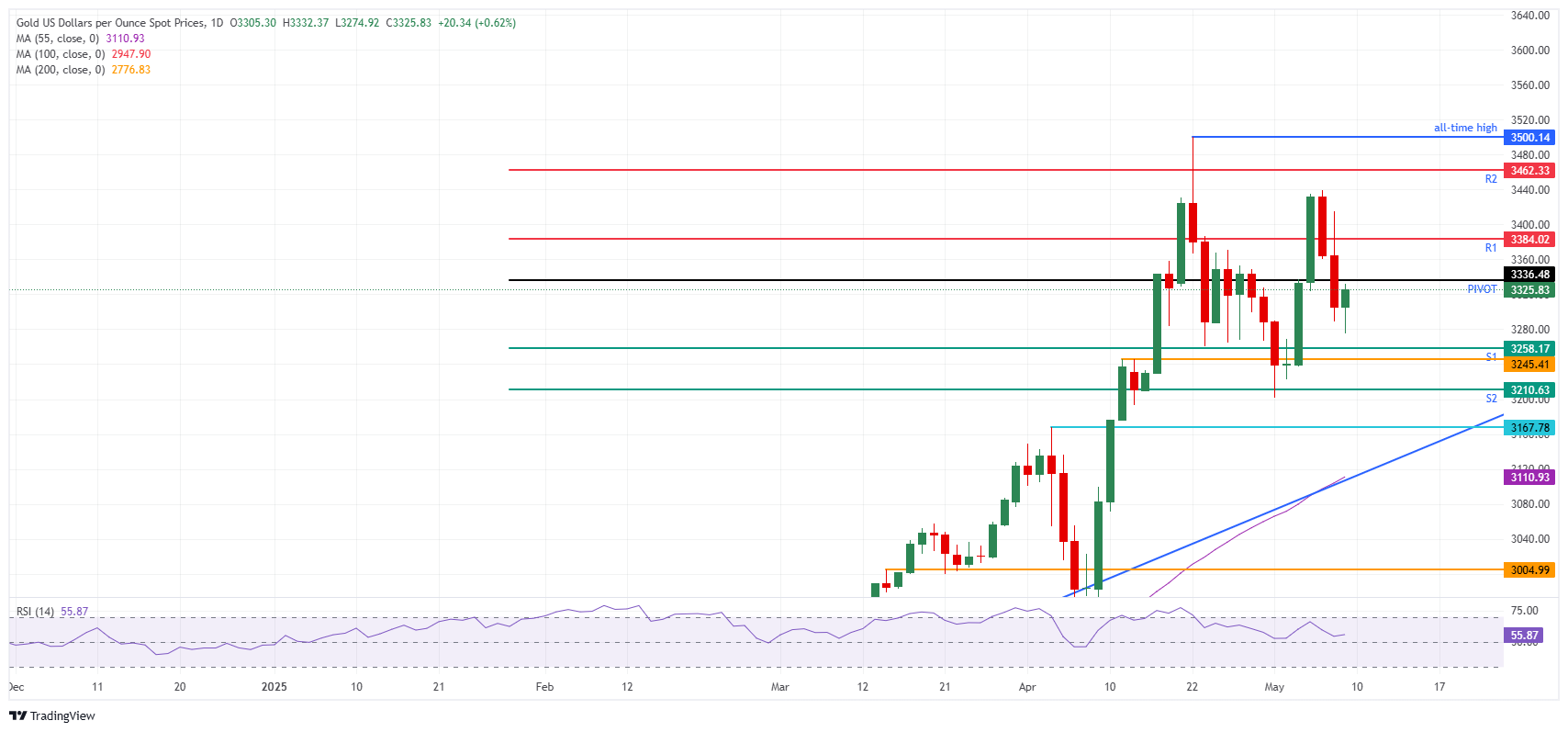Gold rebounds as Dollar retreats ahead of US-China trade talks this weekend
- Gold price recovers initial losses and trades back above $3,300 on Friday.
- The US-UK trade agreement is for cheering markets, not a ‘full and comprehensive’ trade deal as President Trump announced.
- Gold sees safe-haven inflow ahead of the high-stakes China-US meeting over the weekend.
Gold (XAU/USD) pops just shy of 1% on Friday and heads back above $3,325 at the time of writing. The precious metal’s price is edging higher as markets call the trade deal announced on Thursday between the United States (US) and the United Kingdom (UK) a ‘nothingburger’. The US-UK trade deal gives the US better market access and a faster customs process for exports to Britain, but falls short of a "full and comprehensive" agreement. At the same time, 10% tariffs will remain in place and the UK will be forced to take $10 billion worth of orders with Boeing, Bloomberg reports.
The fact that this initial trade deal for the US is so ill-conceived raises big questions and uncertainties just ahead of the China-US summit that is set to take place in Switzerland over the weekend. In the run-up to that meeting, the Chinese Minister of Commerce has again expressed its demands that tariffs must be unwound before trade talks can occur. Meanwhile, US President Donald Trump hinted overnight that people should head out and buy stocks now, Reuters reports.
Daily digest market movers: That is not a trade deal at all
- President Trump also said overnight that he believed that the trade talks this weekend with China would result in tangible progress. The president said he would consider lowering the 145% tariff he has imposed on many Chinese goods if the discussions went well. Beijing, meanwhile, reiterated its calls for the US to cancel unilateral duties on China, Bloomberg reports.
- People familiar with preparations for the talks, which are due to begin in Geneva on Saturday, led by US Treasury Secretary Scott Bessent and Chinese Vice Premier He Lifeng, say the US side has set a target of reducing tariffs below 60% as a first step that they feel China may be prepared to match. Progress in two days of scheduled discussions could see those cuts being implemented as soon as next week, they said, Bloomberg reports.
- "Buying Gold on dips is still in vogue, which is so far limiting the downside moves despite safe-haven demand drying up to a degree on the US-UK trade deal," KCM Trade Chief Market Analyst Tim Waterer said, Reuters reports.
Gold Price Technical Analysis: It will all end in tears
The stakes just got high for this weekend, after President Trump told people to go out and buy stocks when talking about the US-UK trade deal, as it would be the first of many. I'm unsure if the suggestion was linked to the US-China negotiations this weekend, though Trump is clearly seizing this one-deal event as a jumping board to get momentum going. However, questions all around should support the safe haven demand due to growing uncertainty.
First hurdle on the upside this Friday comes in at the daily Pivot Point at $3,336. Should more follow-through appear later in the day, look for the intraday R1 resistance at $3,384. The R2 resistance upside target at $3,462 might be a bit too far for today’s price action.
On the downside, the S1 support at $3,258 is the first line of defence. The watchdog level, which is near $3,245, is a much stronger floor from a technical standpoint. In case it does break under pressure, $3,210, which is the S2 support, should come into play.

XAU/USD: Daily Chart
Gold FAQs
Gold has played a key role in human’s history as it has been widely used as a store of value and medium of exchange. Currently, apart from its shine and usage for jewelry, the precious metal is widely seen as a safe-haven asset, meaning that it is considered a good investment during turbulent times. Gold is also widely seen as a hedge against inflation and against depreciating currencies as it doesn’t rely on any specific issuer or government.
Central banks are the biggest Gold holders. In their aim to support their currencies in turbulent times, central banks tend to diversify their reserves and buy Gold to improve the perceived strength of the economy and the currency. High Gold reserves can be a source of trust for a country’s solvency. Central banks added 1,136 tonnes of Gold worth around $70 billion to their reserves in 2022, according to data from the World Gold Council. This is the highest yearly purchase since records began. Central banks from emerging economies such as China, India and Turkey are quickly increasing their Gold reserves.
Gold has an inverse correlation with the US Dollar and US Treasuries, which are both major reserve and safe-haven assets. When the Dollar depreciates, Gold tends to rise, enabling investors and central banks to diversify their assets in turbulent times. Gold is also inversely correlated with risk assets. A rally in the stock market tends to weaken Gold price, while sell-offs in riskier markets tend to favor the precious metal.
The price can move due to a wide range of factors. Geopolitical instability or fears of a deep recession can quickly make Gold price escalate due to its safe-haven status. As a yield-less asset, Gold tends to rise with lower interest rates, while higher cost of money usually weighs down on the yellow metal. Still, most moves depend on how the US Dollar (USD) behaves as the asset is priced in dollars (XAU/USD). A strong Dollar tends to keep the price of Gold controlled, whereas a weaker Dollar is likely to push Gold prices up.

